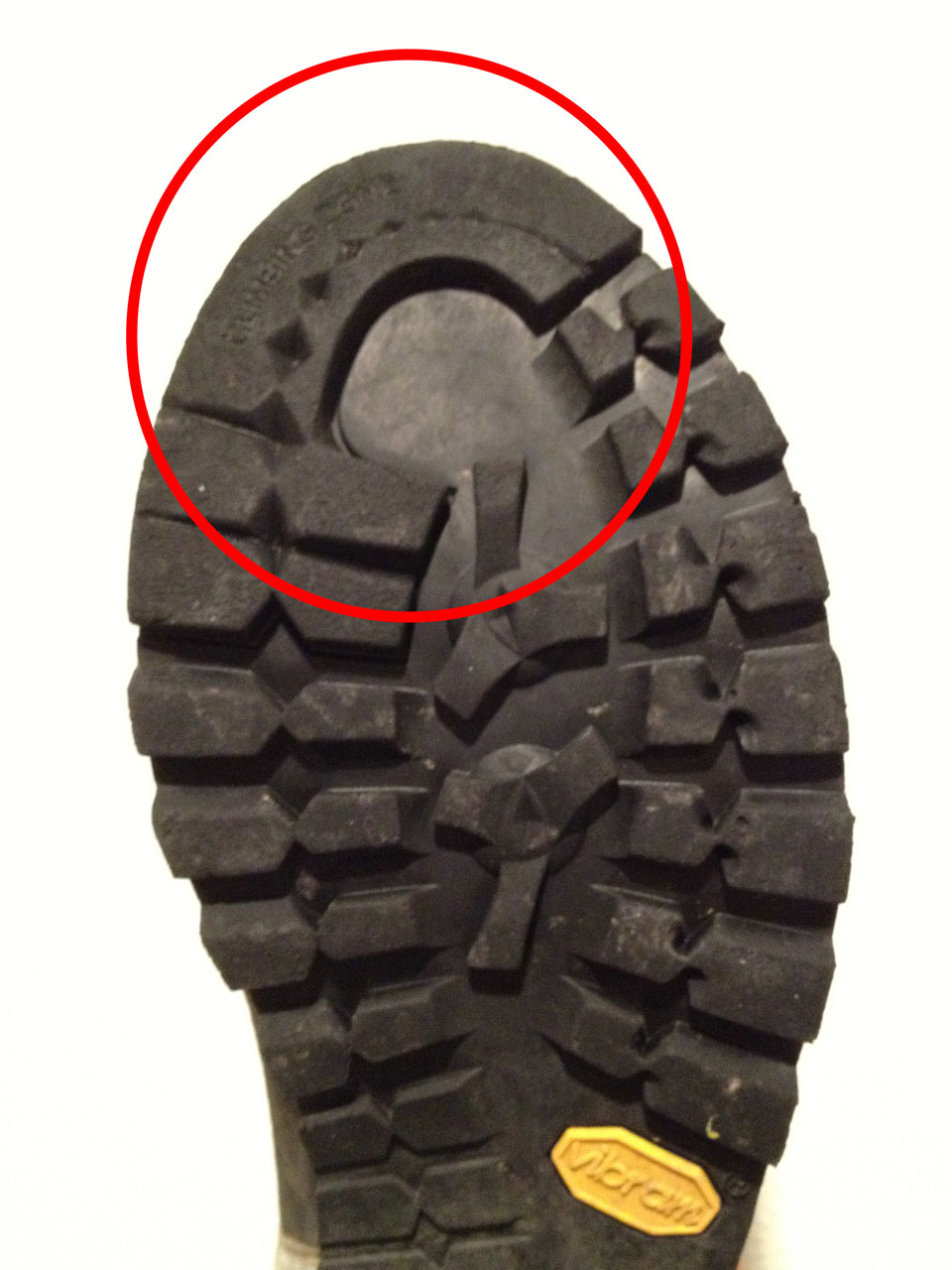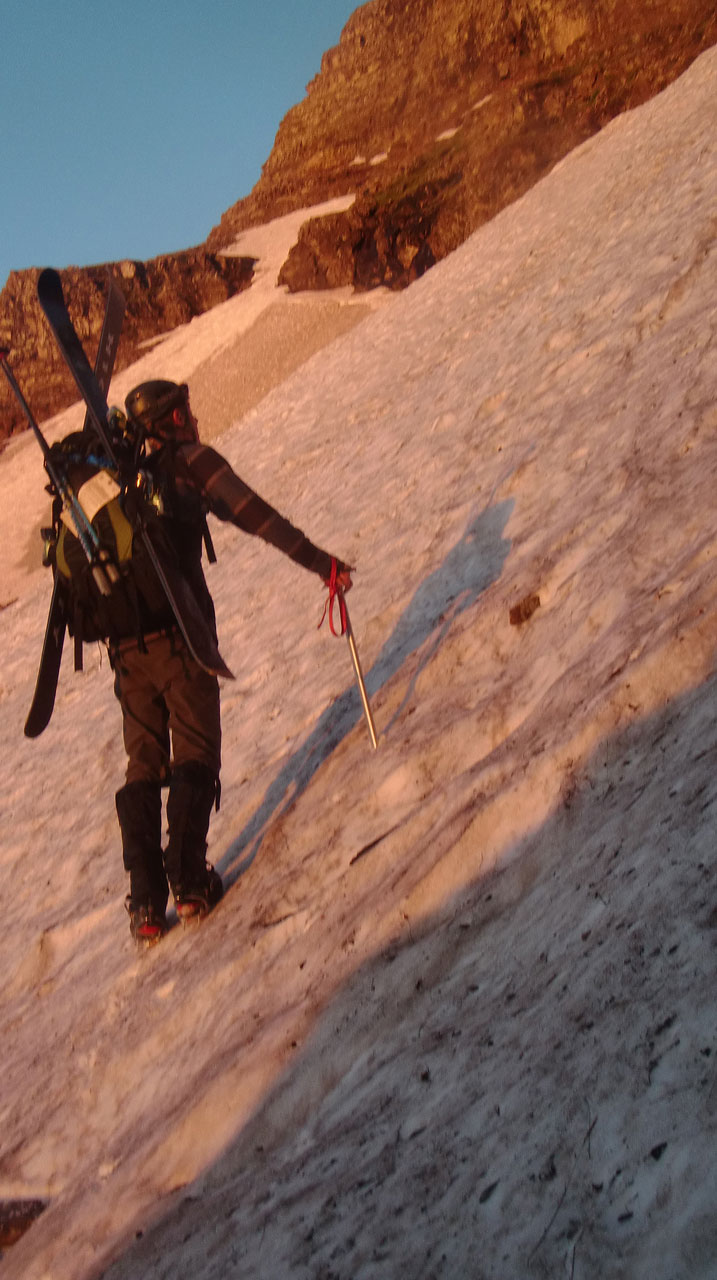Performance
I have taken my Raven’s through the gamut of their advertised abilities: “technical alpine routes and backpacking/trekking on technical and challenging terrain.” The Raven’s have performed fantastically in all situations, with very few caveats.
On rock, the Raven’s climb confidently. From third- through fifth-class rock (scrambling to vertical) the Raven’s perform well. Any route I feel comfortable soloing in my rock shoes, I would confidently solo in the Raven’s (except perhaps that friction move at the top of the 3rd Flatiron…).
The “Climb Zone” that is incorporated into the Vibram Mulaz sole will be familiar ground to those of us who are used to the sticky rubber coated torture chambers that are rock climbing shoes. The climbing zone is an area of flat rubber that wraps from the big toe toward the inside of the foot—the primary areas of the foot used in technical climbing. As opposed to the terrifying experience of trying to edge on a fully lugged boot, the climb zone allows for confident and precise climbing without sacrificing traction elsewhere on the trail.

The full-wrap rubber rand also improves performance and durability on rock. I feel comfortable climbing in these boots for long stretches of low fifth-class climbing and scrambling. The Vibram sole is not sticky rubber, but it is definitely softer than many of the Vibram soles on other boots I’ve used. This makes for good climbing at the cost of being somewhat less durable.
The Ravens climb well on steep snow also. My Black Diamond Sabretooth semi-automatic crampons fit well and perform up to par. There is a very slight flex in the sole that is noticeable when front pointing into firm snow (firm in the sense that I could only get my two front points into it) that is ~45º and over—the sole flexes just under the ball of the foot. The flex is just barely noticeable, but I can imagine that in climbing vertical ice/mixed, this could become a bit of an issue.

While backpacking, the boot walks very naturally. I attribute this mostly to the generously rockered sole. In comparison, my La Sportiva Trango’s have a nearly flat sole. The majority of the rocker in the sole of the Raven’s occurs right under the ball of the foot and extends toward the toe. Behind the ball of the foot, the boot is flat.
This amount of rocker in the sole does detract a bit from cramponing and climbing performance. For me, however, these miniscule performance compromises are easily worth the improved walking comfort. The idea of backpacking in my Trango’s, for example, is not a pleasant thought. They are difficult to walk in. The lack of rocker in the sole of the Trango’s means that the walking stroke involves a heel strike followed by the entire sole crashing to the ground at one time as I attempt to transition to the ball of my foot. In the Ravens, the combination of the rockered sole and great range of motion in the ankle make this a very viable backpacking boot.
I have one qualm with hiking in these boots, and I think it is a function of the rigid soles (rather than being a fit issue). I find that after long days of hiking/climbing, I occasionally start to get hot spots on the balls of my feet. It feels like this is caused by the added pressure on the balls of my feet while walking. In a boot with a flexible sole, the force of my step is distributed to larger part of my forefoot, which includes my toes. With the stiff sole, the force of my step is concentrated on the balls of my feet, and my toes hardly absorb any force. Because my toes don’t contribute much to my walking stride, the balls of my feet end up bearing the brunt of the force, and I think this is contributing to these hot spots.
The good news is that, so far, none of these hot spots have formed blisters, and I have hiked many miles while feeling these hot spots with no more than slight discomfort.
Water Repellancy
The Raven has a Gore-Tex membrane, hence the boots are essentially 100% waterproof. They come with a good DWR coating as well that keeps them from soaking through. However, there is no Gore-Tex membrane in the neoprene gator, and the sewing for this gator is not seam sealed, so water can get in at the base of the neoprene. Water does not get in here quickly, but if you are standing in a stream and the water line is over that seam, you will get wet after a minute or two. This seam is located ~2” lower than the top of the boot, in the back.

How would you rate this boot for climbing mont blanc obviously using winter socks plus neoprene socks ?? would it be cold on my feet ????
Hey Jordan,
I have never climbed Mont Blanc, so I cannot say for certain how the Ravens would perform warmth wise. Technically I think they will be great though. I think it mostly depends on how warm/cold your feet run. Like I mentioned, this boot does not have as much insulation as some of its competitors, so if your feet tend to run warm, you may be fine. But if your feet tend to run colder, this boot might be a touch cold.
Sorry I couldn’t be more specific!
-Sam
How suitable would you rate these boots for summer scrambling / mountain walking in Snowdonia, Cairngorms etc ?
Marc
Hi Marc,
Although I have never climbed in the UK, judging from a little internet research I would say the Raven’s might be a bit overkill. Unless you are planning to use crampons at somepoint, I would definitely suggest a boot without a full shank. I think the Ravens would be much better suited for 3 season mountaineering in the Alps.
Scrambling/mountain walking sounds like a climbing approach shoe might be a good option, especially if you plan on doing more scrambling than hiking,
Thanks,
Sam
Hello, I am looking for a solid boot for scottish ice climbing, and for larger routes in the Alps, I currently use the Rapace, and took them up mont blanc, of which my feet froze of course, I was wondering if this boot was a good choice?
Hey Joss,
I think it probably depends what the primary use for the boot will be. If it’s mostly for ice climbing, maybe something that will take automatic crampons would be better. If it’s primarily for the Alps, this would probably be a good choice. For really long routes in he alps, an overbook might be helpful.
I hope that answers your questions.
Sam
Hello everybody,
can i use these boots for climbing Mont Blan ?
Hi,
I am planning to climb Orizba in Mexico in early 2017. I am new to this and looking for boots that I can take there. I was told I’ll need crampons. Do you think these boots are a good option?
I think these boots are a great options for Orziba. This should be good level of warmth for tropical high peaks and if you are on one of the standard routes, the Raven should be plenty stiff for using crampons in steep snow. Just make sure you try them on in a shop and that they fit well, then break them in!
Hello everybody,
Can I use these boots for climbing Damavand in Iran ?
Hi Hasna,
Though I have no experience with this specific peak or region, I think the Raven could be a good choice if you tend to have warm feet. If you have poor circulation in your feet or otherwise tend to get cold feet easier than others in general, it might be a good idea to get a slightly warmer boot.
Good luck with your ascent!
Sam
Hello,
I already have a pair and climbed Mt. Adams WA Aug 2017. They worked perfectly for that condition. I plan on climbing Mt. Rainier Aug/Sept 2018. I want to use my own boots but not sure if they are adequate. Appreciate any advice. My feet may get cold just like any body but not in particular.
Hey Tim, I climbed Rainier last spring and can definitely say that Mont Blanc was colder (at least for the times I’ve been on the peak).
The Raven is perfect for peaks like Rainier and Mont Blanc. You shouldn’t have a problem.
Congrats on Adams!!
Hi,
I used the latest design raven 3 this week to climb Mt Rolleston, Arthurs pass NZ, absolutely loved them but unfortunately the 3F cable system thingy on both boots failed, the cables pulled out from the side of the boot.